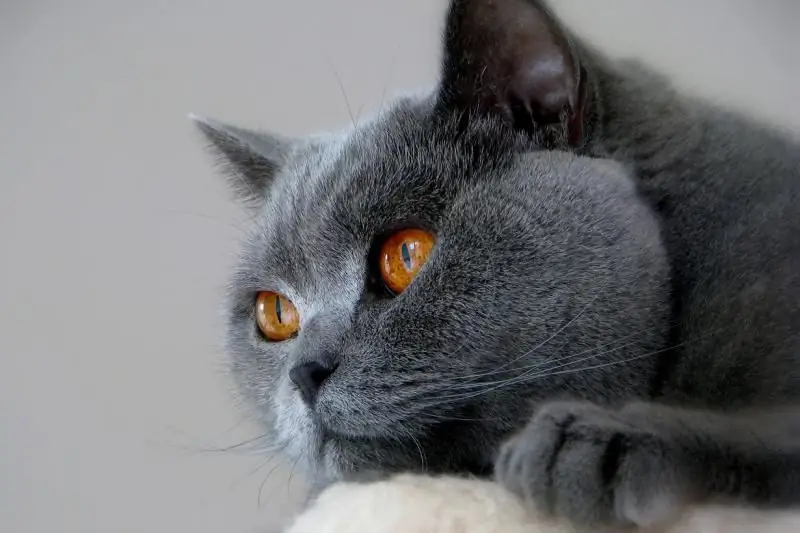
Table of contents:
- Viral enteritis in cats: how to prevent danger
- What is viral enteritis
- The main causes of the disease
- Types of viral enteritis
- When you need to urgently see a veterinarian
- How to treat a disease at home
- Features of the treatment of pregnant cats and kittens
- Prevention of enteritis in a pet
- Veterinarian recommendations
- Author Bailey Albertson [email protected].
- Public 2024-01-17 22:26.
- Last modified 2025-06-01 07:32.
Viral enteritis in cats: how to prevent danger
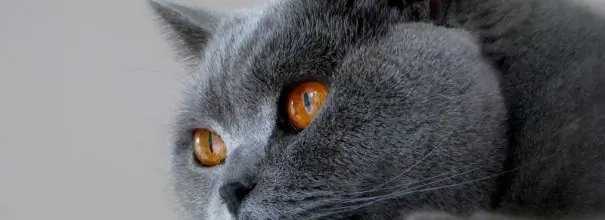
Many owners from time to time notice that the cat has loose stools, and the pet's health has deteriorated somewhat. Often these violations are attributed to errors in the cat's diet, and they are not given much importance. At the same time, a group of infectious diseases has similar symptoms - viral enteritis, which are characterized by rapid development and unpredictable, sometimes very serious consequences.
Content
- 1 What is viral enteritis
-
2 The main causes of the disease
2.1 Factors contributing to the development of the disease
-
3 Types of viral enteritis
-
3.1 Coronavirus enteritis
3.1.1 Video: coronavirus in cats
- 3.2 Parvovirus enteritis
- 3.3 Rotavirus enteritis
-
-
4 When you need to urgently contact the veterinarian
4.1 Diagnosis of enteritis
-
5 How to treat a disease at home
- 5.1 First aid for a pet
-
5.2 Treatment of viral enteritis
- 5.2.1 Table: Medicines for the treatment of viral enteritis
- 5.2.2 Photo gallery: drugs for the treatment of enteritis
- 5.2.3 Video: What to do with diarrhea in cats
- 5.3 The use of traditional medicine
- 5.4 Taking care of sick animals
- 6 Features of the treatment of pregnant cats and kittens
- 7 Prevention of enteritis in a pet
- 8 Recommendations of veterinarians
What is viral enteritis
Viral enteritis is a group of diseases in which inflammation of the small intestine occurs as a result of infection with certain viruses.
Viral enteritis stands apart from the rest of the enteritis group for a reason, they are characterized by:
- high infectivity;
- the rapid onset of the disease;
- affecting mainly young animals that have not been vaccinated.
There are enteritis caused by other reasons:
- poisoning;
- improper diet;
- helminths;
- the simplest;
- bacteria;
- allergic reactions.
Therefore, often when making a diagnosis, the doctor conducts differential diagnostics within the group of these diseases.

The severity of the condition with all enteritis causes dehydration and electrolyte imbalance, which develop with vomiting and diarrhea
The main causes of the disease
The cause of the disease is infection with a specific viral pathogen. It occurs through the oral and contact routes.
Factors contributing to the development of the disease
Contribute to infection and disease development:
- neglect of vaccine prevention;
- crowding when keeping cats;
- free range for cats;
- non-compliance with hygiene measures;
- the presence of concomitant diseases;
- poor food quality;
- elderly and children's age of pets, kittens that have just lost their maternal antibodies are especially vulnerable;
- stress.
Types of viral enteritis
There are many viruses leading to the development of enteritis in cats, but the greatest clinical significance are:
- coronavirus infection;
- parvovirus infection;
- rotavirus infection.
These types of enteritis are most common and form the bulk of the overall incidence of viral enteritis in cats.
Coronavirus enteritis
Coronavirus enteritis is caused by RNA-containing agents that provoke two highly contagious diseases:
- coronavirus enteritis, which affects mainly young, elderly animals, as well as those with concomitant diseases and immunodeficiency states, but rarely leading to death;
-
infectious peritonitis, mortality in which reaches 100%.

Feline coronavirus Coronavirus has two varieties and causes feline coronavirus enteritis, which has a good prognosis, as well as infectious peritonitis, the mortality rate from which is close to 100%
Transmission most often occurs through feces when using a common tray, somewhat less often through saliva.
Coronavirus enteritis is relatively easy and manifests itself:
- fever (not always);
- loss of appetite;
- flatulence, bloating;
- vomiting;
- diarrhea, reddish stools.
The disease lasts 2-4 days. Recovered cats acquire immunity, but the formation of a chronic carrier of the virus is possible. Adult cats with strong immunity are resistant to the pathogen and do not show symptoms of the disease when they encounter it. Also, the danger of the disease lies in the possibility of mutation in the body of a cat of a coronavirus that causes enteritis into a virus leading to infectious peritonitis.
Video: coronavirus in cats
Parvovirus enteritis
The most dangerous highly contagious disease, also called panleukopenia, or feline distemper. The causative agent is extremely stable in the external environment and can be stored for up to a year at room temperature, it is destroyed by a limited number of disinfectants - formaldehyde, hypochlorite. Mortality is approaching 90%, and not only kittens die, but also adult pets.
Parvovirus enteritis has additional transmission routes:
- vertical - from sick mother to kittens;
- transmissible - through insect bites.
The virus infects cells that divide rapidly:
- the epithelium of the intestinal villi, causing their destruction and making the absorption process impossible;
- bone marrow - destroys leukocyte germ cells;
- lymphatic tissues - affects lymphocytes.
The incubation period usually lasts 2-10 days.

Panleukopenia is deadly for kittens and adult animals.
Parvovirus enteritis symptoms:
- high body temperature (up to 40-41 0 С), its sharp drop usually precedes the death of the cat;
- general oppression;
- refusal to eat;
- thirst, but the cat refuses water;
- stomach ache;
- diarrhea, the stool contains blood and scraps of the mucous membrane of the small intestine, in severe cases, the mucous membrane exfoliates and is separated by a "stocking";
- sometimes note the appearance of a small red spotted rash on the skin with the subsequent development of pustules (bubbles);
- increasing dehydration and electrolyte disturbances;
-
symptoms of secondary bacterial infections that develop against the background of damage to the immune system appear (theoretically, bacterial complications of any localization are possible):
- rhinotracheitis;
- pneumonia;
- pyelonephritis;
- sudden death - this is how the fulminant form of parvovirus enteritis manifests itself;
- with intrauterine infection, as well as with infection during the neonatal period, kittens develop cerebellar damage.
In order for the cat to survive, it is necessary to have time to compensate for the loss of fluid, as well as violations of electrolyte metabolism; with the development of bacterial complications - to fight them. If you manage to cope in the first 5-7 days of the illness, as a rule, the cat gets better, while a tense and stable immunity is formed. Some pets form a carrier of the virus, and they become a reservoir and source of infection for other animals, and in cases of pregnant cats, their own kittens.

It is vital to restore the volume of lost fluid and electrolytes in case of enteritis
Rotavirus enteritis
The causative agent is rotavirus, which infects the small intestine and stomach. A favorite site of lesion is the epithelium of the apex of the intestinal villi, which causes impaired breakdown and absorption of nutrients, as well as an inflammatory response. When infected with this virus, some researchers do not rule out the dust-air path. Kittens are most often affected, especially those who are bottle-fed.
Infection symptoms:
- fever with an increase in temperature up to 40 0 С;
- at the onset of the disease, anxiety and motor excitement of the kitten is possible;
- vomiting;
- diarrhea, there may be an admixture of blood and mucus in the stool;
- development of dehydration is possible.
Usually, recovery occurs within 3-10 days, deaths are rare.
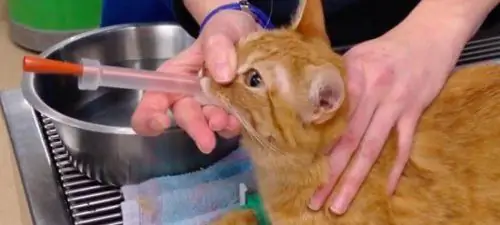
If there is no vomiting, but there is diarrhea, saline solutions are fed from a syringe
When you need to urgently see a veterinarian
Considering that enteritis is a group of diseases with similar symptoms, while differing both in the severity of the course and danger to health, and for the reasons that caused them, you should consult a doctor at the first signs of enteritis.
Ideally, you should not try to treat the cat yourself before going to the doctor, because:
- measures aimed at stopping nausea and vomiting are carried out only under the guise of antibiotics, otherwise it will increase intoxication;
- the use of human remedies to reduce fever will cause gastrointestinal bleeding in the cat;
- it is necessary to correctly calculate the volume of fluid to fill the deficit formed in the pet.
Diagnosis of enteritis
When making a diagnosis, the doctor examines the cat and asks the owner how the disease developed, as well as about the vaccinations given to the pet. Methods of additional diagnostics are of great importance:
- General blood count - with parvovirus enteritis, a decrease in leukocytes is characteristic, with other viral infections due to the addition of bacterial flora, their increase will be. Also, a complete blood count can help identify dehydration by determining the volume of red blood cells.
- A general urinalysis allows you to assess the function of the kidneys, as well as their possible involvement in panleukopenia.
- Biochemical blood test - determines the functional state of organs, the latent chronic diseases of which, possibly, formed the background for the development of the disease, and also need to be taken into account when drawing up a therapy regimen.
- General analysis of feces - microscopy of feces is carried out in order to identify microbial pathogens, the degree of dysfunction of digestion, the severity of inflammatory changes.
- Serological studies to determine the antigens of viruses or the titer of antibodies to them. Both blood and feces can serve as materials.
It is impossible to independently establish the cause of enteritis, and this is important for predicting both the severity of the disease and its outcomes, including remote ones.

You should take your pet to the doctor at the first signs of enteritis, since the treatment of this disease is symptomatic, and its success depends on the timeliness of the start of therapy
How to treat a disease at home
At home, the appointment of a veterinarian is carried out.
First aid for a pet
First aid should be provided in a veterinary clinic, since with viral enteritis dehydration develops very quickly, worsening the course of the disease and its prognosis.
Treatment of viral enteritis
There is no etiotropic therapy aimed at destroying the virus. Symptomatic treatment is carried out, therefore, early initiation of therapy can significantly alleviate the course of the disease.
The main goals of symptomatic therapy are:
- restoration of the volume of lost fluid;
- restoration of electrolyte balance;
- suppression of the growth of secondary bacterial flora.
Treatment usually includes:
-
broad spectrum antibacterial drugs:
- cephalosporins;
- amoxicillin in combination with clavulanic acid;
-
subcutaneous or intravenous fluid administration:
- 5% glucose solution;
- Ringer's lactate solution;
-
in the absence of vomiting - oral rehydration with drinking solutions:
- Oralita;
- Regidron;
- Pedialitis;
- antiemetics: metoclopromide - to reduce water and electrolyte losses;
- cardiac drugs: sulfocamphocaine to maintain heart function;
- antacids for prolonged fasting: Kvamatel - to protect the gastric mucosa;
- enveloping agents: Almagel - also to protect the mucous membrane;
-
sorbents:
- Activated carbon;
- Lignin;
- Smectu - for binding and removing toxins that are formed in the intestinal lumen;
-
in the presence of blood impurities in case of diarrhea - hemostatic drugs:
- Vikasol;
- aminocaproic acid;
- for a cauterizing effect on ulcerative damage to the mucous membrane - a bismuth preparation (De-Nol);
- for the treatment of parvovirus gastroenteritis, there is a hyperimmune serum, the introduction of which makes sense in the first 5 days of the disease;
- vitamin therapy - to restore metabolism, B vitamins and ascorbic acid are administered;
-
immunocorrectors:
- Gamavite;
- Fosprenil.
Table: Medicines for the treatment of viral enteritis
| Name | Structure | Operating principle | Price, rubles |
| Sinulox |
|
Broad-spectrum antibacterial drug. Do not use during pregnancy and lactation. | 910 |
| Claforan | Cefotaxime | Broad-spectrum antibacterial drug. Do not use during pregnancy and lactation. | from 81 |
| Regidron |
|
For the correction of electrolyte disturbances in dehydration associated with vomiting and diarrhea | from 355 |
| Cerucal | Metoclopromide | Antiemetic - to reduce the loss of water and electrolytes; increases the tone of the stomach and intestines while weakening their peristalsis. It is impossible in the first half of pregnancy and during lactation; in the second half of pregnancy, it is prescribed for health reasons. | from 112 |
| Kvamatel | Famotidine | Suppresses gastric secretion and protects the mucous membrane of the digestive system from the corrosive action of gastric juice; appointed for the period of the cat's fasting diet. It is impossible during pregnancy and lactation. | from 126 |
| De-Nol | Bismuth tripotassium dicitrate | Protects the mucous membrane, is able to inhibit the growth of certain types of bacterial flora. It is impossible during pregnancy and lactation. | from 249 |
| Smecta | Dioctahedral smectite | Absorbent; promotes the binding and removal of viruses, bacteria, their toxins, and inflammation products from the intestines. It is possible during pregnancy and lactation. | from 144 |
| Aminocaproic acid | Aminocaproic acid | Hemostatic agent; prescribed for signs of intestinal bleeding with enteritis | from 34 |
| Fosprenil | Disodium salt of polyprenol phosphate | Strengthens the cellular and humoral immune response, facilitates and shortens the course of the disease. It is possible during pregnancy and breastfeeding. | from 170 |
Photo gallery: drugs for the treatment of enteritis
-

Regidron - Rehydron restores electrolyte balance during dehydration
-

Cerucal - Cerucal is prescribed for uncontrollable vomiting.
-

Kvamatel - Kvamatel protects the gastric mucosa from the aggressive effects of gastric juice
-

De-Nol - De-Nol protects the gastric mucosa, has anti-inflammatory and antibacterial properties
-

Smecta - Smecta introduces toxins from the body formed as a result of the activity of viruses and bacteria
-

Fosprenil - Fosprenil is an innovative natural medicine for treating viral infections in cats and dogs
-

Sinulox suspension - Sinulox is a broad-spectrum antibiotic of the penicillin series
Video: what to do with diarrhea in cats
The use of traditional medicine
Treatment of viral enteritis with prescribed medications can be supplemented with traditional medicine, having previously agreed on their use with a veterinarian. The following recipes may be helpful:
-
Decoction of rice. It has an enveloping, soothing and antidiarrheal effect:
- Pour 1 tablespoon of rice with a glass of water.
- Bring to a boil and cook for 40 minutes, replenishing the evaporating liquid.
- Filter the resulting white viscous broth and give the cat 1 tablespoon several times a day.
-
Hypericum infusion. St. John's wort has astringent, antimicrobial, hemostatic and anti-inflammatory effects. The plant is poisonous, so the dosage should be strictly observed:
- 10 g of dry herb St. John's wort pour 200 ml of water.
- Soak for 30 minutes in a boiling water bath.
- Dosage - 1 ml per 1 kg of body weight, divide the daily dose into 3 doses.
- Hypericum infusion is given half an hour before feeding.
-
Nettle infusion is a hemostatic, anti-inflammatory and healing agent:
- Pour 25 g of dry nettle leaves with 500 ml of water.
- Put in a boiling water bath for 30 minutes, then remove and filter.
- Use 1 teaspoon 3 times a day.
-
Decoction of oak bark - has antimicrobial, anti-inflammatory, astringent and hemostatic effects:
- Pour 20 g of oak bark with a glass of boiling water and continue to boil for 20 minutes.
- Cool and filter.
- Apply 1 tablespoon 3 times a day.
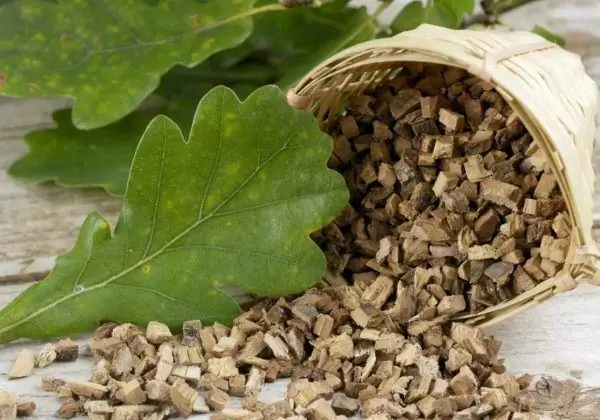
Traditional medicines can help in the treatment of enteritis, but their use should be agreed with a veterinarian
Caring for a sick animal
A large role in care is given to replenishing the amount of lost fluid - it should be considered how many times and in what volume there was vomiting or loose stools. If vomiting persists, at home, liquid (5% glucose solution or 0.9% sodium chloride solution) can be injected subcutaneously; if there is only diarrhea, then drink in the form of solutions.
It is possible to start fighting vomiting and diarrhea only under the guise of antibiotic therapy. The cat should not be fed for the first 1-2 days, then he can be offered meat broth, a little mixture of boiled rice and minced meat with broth, as well as canned food from the veterinary line Gastro Intestinal.

Royal Canin Gastro Intestinal for cats is prescribed for diarrhea, gastritis, intestinal inflammation, colitis, anorexia, poor digestion and absorption of nutrients
The cat needs to be kept in a warm room, to monitor the cleanliness of its litter box, as well as its coat. A timely visit to the veterinarian is of great importance, since only a doctor can assess the dynamics of the course of the disease and timely make changes to the therapy regimen.
Features of the treatment of pregnant cats and kittens
With viral enteritis of a pregnant cat, treatment is carried out only by a veterinarian with a careful choice of antibacterial drugs. In panleukopenia, the treatment regimen is chosen exclusively in the interests of the cat, since the pregnancy outcome is expected to be unfavorable.
In cases where a mother cat is a carrier of the coronavirus, the kittens are separated after childbirth and artificially fed. They must be examined for viruses.
Treatment of sick kittens is carried out, focusing on the principles adopted for adult cats. The compensatory capabilities of the kitten's body are small, so dehydration is a huge danger for them.
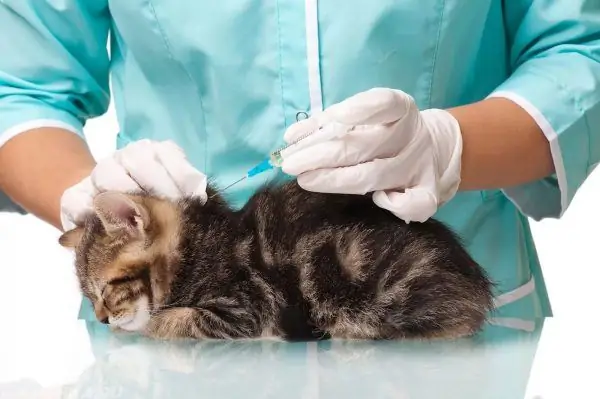
Vaccination is the only protection against parvovirus enteritis
Prevention of enteritis in a pet
Measures for the prevention of infectious enteritis include:
-
compliance with the terms of routine vaccination:
- vaccination against panleukopenia is mandatory and reliably protects the pet, reducing his likelihood of developing a severe form of the disease;
- a vaccine has been developed against the coronavirus, but while vaccination is experimental and is being carried out in a number of North American countries, its effectiveness is being studied, the priority here, of course, is the prevention of infectious peritonitis;
- feeding cats with high-quality and complete food;
- keeping the litter box clean, if there are a lot of cats - there should be several trays, the litter should not become dusty;
- deworming once a quarter;
- timely detection and treatment of chronic diseases;
-
reception of Maltpasta by long-haired cats to eliminate intestinal irritation with pylobezoars (hairballs);

Maltpasta for cats Maltpasta promotes the elimination of hair from the body of cats
- limiting cat contacts with stray animals;
- thorough preparation for pregnancy of a cat, including the identification of possible virus carriers;
- removing virus carriers from breeding programs;
- quarantine of cats with serological diagnostics of viral infections when a new cat is introduced into the formed feline collective.
Veterinarian recommendations
If diarrhea is found in a cat in combination with a violation of general well-being, and even more so vomiting, you should contact the veterinarian, since it is possible that the pet has an infectious enteritis. The causative agents are viruses, and a specific treatment for these diseases has not been developed. Methods of symptomatic therapy are used, and the success of treatment depends on how timely it was to start. Viral enteritis is especially dangerous for kittens, unvaccinated, elderly animals, as well as pets with concomitant pathology. Only in a veterinary clinic will they be able to make the correct diagnosis, as well as prescribe the necessary therapy.
Recommended:
Lice Beetles In Cats: Photos Of Lice And Symptoms Of Their Lesion On The Skin, Diagnosis, Treatment And Prevention At Home

The causative agent of feline trichodectosis looks like the main symptoms. Complications of trichodectosis. How to detect and cure. Prevention of trichodectosis
Renal Failure In Cats And Cats: Symptoms, Treatment, How To Save A Kitten And An Adult Animal (recommendations Of Veterinarians)

Types of renal failure in cats The reasons for its development. How pathology manifests itself and is diagnosed. Inpatient and home treatment. Prevention
Eosinophilic Granuloma In Cats: Symptoms And Treatment At Home, Prevention And Recommendations Of Veterinarians
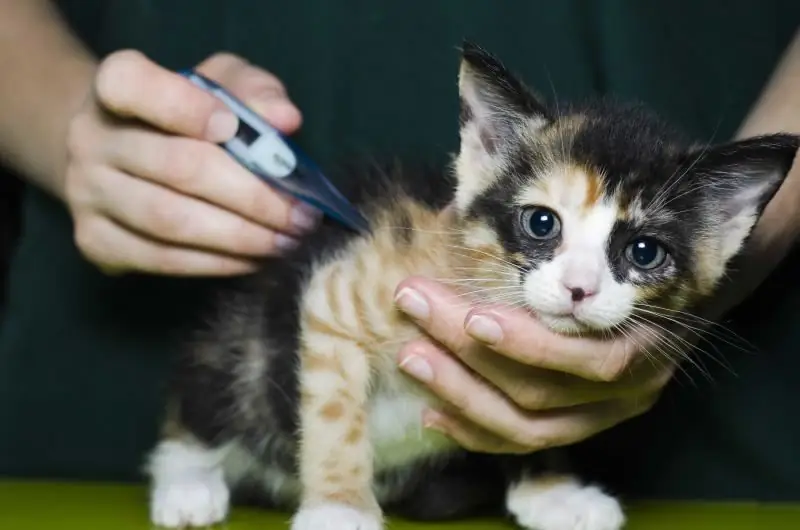
How does eosinophilic granuloma of cats look and proceed? Causes, diagnosis, prevention and treatment methods. Veterinarian recommendations
Flea Dermatitis In Cats: Symptoms (description And Photo), Diagnosis Of The Disease, Its Treatment At Home, Prevention

Features of fleas, the reasons for the development of flea dermatitis. How it develops, symptoms, how to diagnose and treat. Danger to people
Diseases Of The Eyes In Cats: Photos Of Symptoms, Diagnosis And Treatment (including At Home), Recommendations Of Veterinarians

What eye diseases are found in cats? How do they manifest. Treatment rules. Animal care during therapy. Prevention. Veterinarian recommendations
